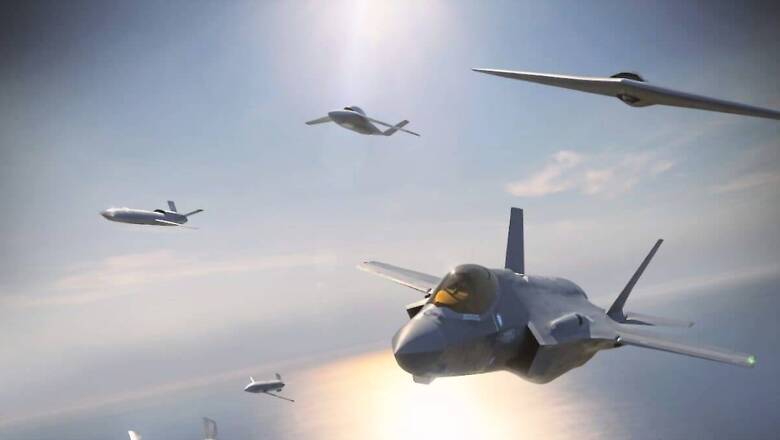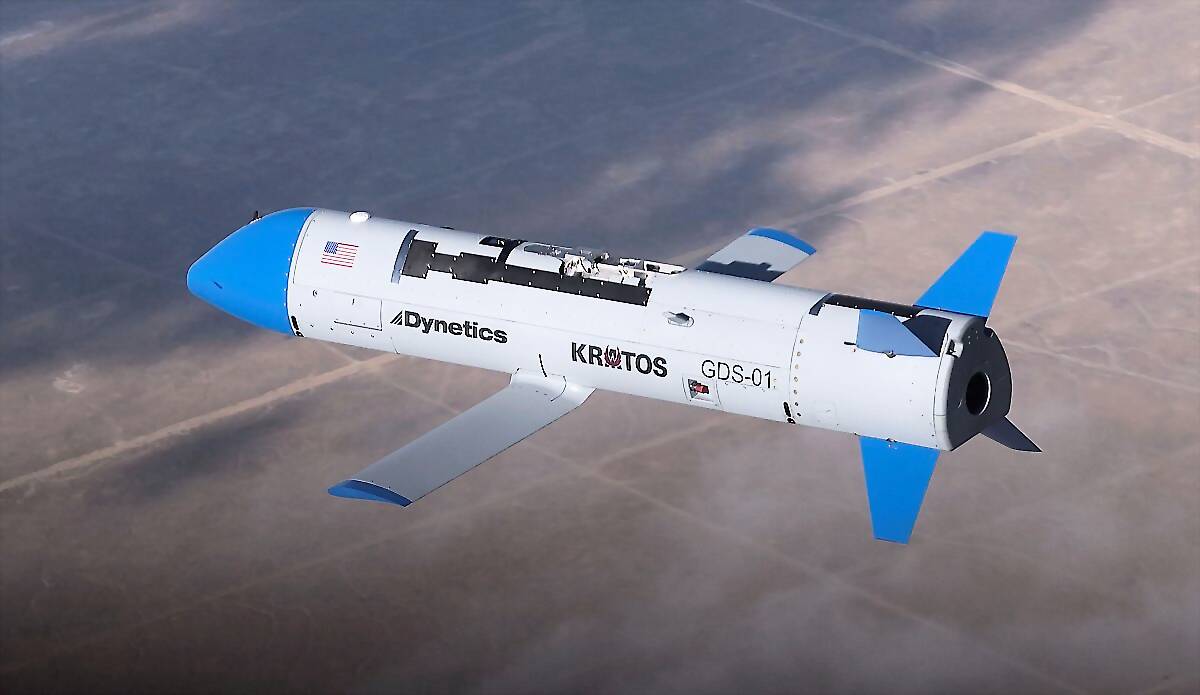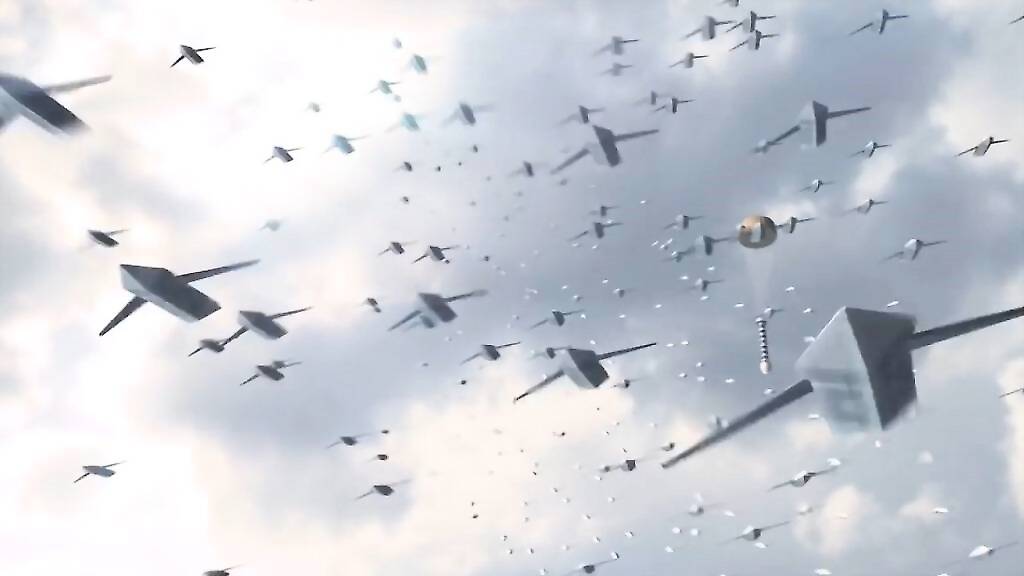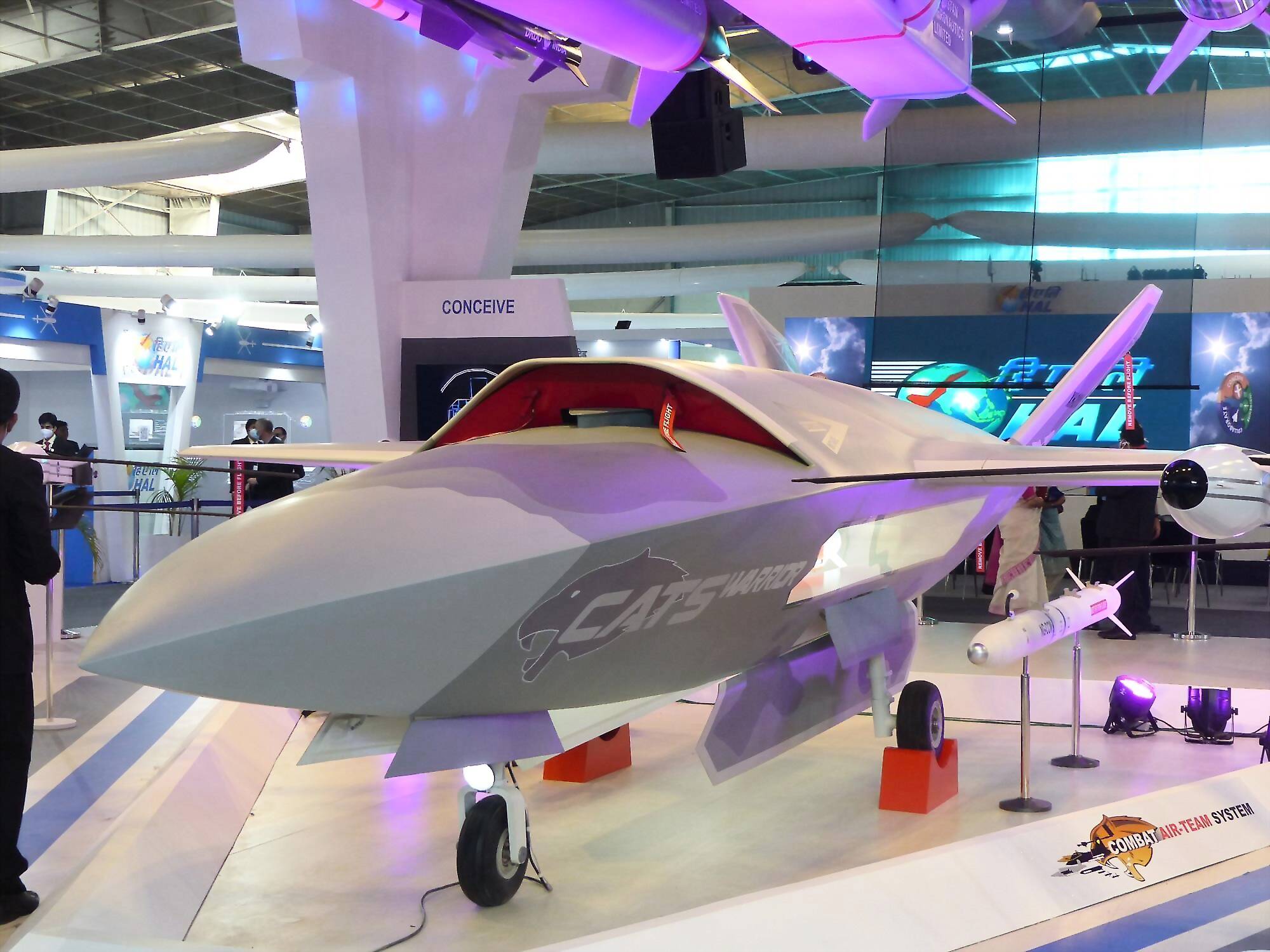
views
Hindustan Aeronautics Ltd (HAL) has announced that flight testing of India’s ‘Loyal Wingman’ warrior drone would begin by 2024. The loyal wingman drones will accompany manned Indian Air Force (IAF) fighter jets. They may be launched from a mother aircraft like the C-130, Jaguar or Su-30 MKI class fighters. They would thereafter be controlled by the fighter through a secure data link. HAL had first displayed a loyal wingman mock-up at their pavilion in Aero India 2021. The indigenous Combat Air Teaming System (CATS) will also have private sector players.
Manned-Unmanned Teaming as a Concept
The maturing of unmanned aerial systems, autonomous operations using artificial intelligence, and more reliable secure data links have made it possible to have a combined mission of manned and unmanned aerial platforms. The Boeing MQ-28 Ghost Bat, previously known as the Boeing Airpower Teaming System (ATS) and the Loyal Wingman project, is a stealth, multirole, unmanned aerial vehicle (UAV). It is designed to work as a smart team with existing military aircraft as a force multiplier and complement and extend airborne missions. Without exposing the more expensive manned aircraft to a high-threat environment, the unmanned wingmen could perform Intelligence Surveillance Reconnaissance (ISR) or tactical early warning missions, and Suppression of Enemy Air Defences (SEAD). The low-cost design allows operators to confidently put it on the front line.
In October 2020, an Apache AH-64E, a Textron Shadow RQ-7BV2 Block 3 tactical UAV and a General Atomics Aeronautical Systems MQ-1C Gray Eagle Extended Range UAV successfully worked together to carry out an air-to-ground missile attack trail. The Franco-German collaboration venture for the Sixth Generation Fighter Aircraft would also include Manned-Unmanned Teaming (MUM-T) technology.
Many wingmen platforms could be as large as a small fighter, have fighter-like performance, be able to fly long ranges and have large endurance. Integrated sensor packages on board could support many missions. They could even carry weapons. They could fly in a variety of formations and could perform coordinate manoeuvres.
US Loyal Wingman Pushing Ahead
Fielding loyal wingman UAVs is a top priority for the US Air Force (USAF). The experimental stealthy unmanned combat aerial vehicle (UCAV) Kratos XQ-58A Valkyrie demonstrator is paired with manned aircraft. The aim is to develop cheaper unmanned alternatives to manned aircraft. Valkyrie would escort the F-22 or F-35 during combat missions, and be able to deploy weapons or surveillance systems. Skyborg is a software and hardware package designed to allow a variety of low-cost, loyal wingman UAVs to fly and carry out missions autonomously. A Skyborg-equipped UAV conducted its maiden flight in April 2021. Northrop Grumman Corporation has designed a new autonomous jet fighter aircraft intended to accompany manned combat jets into battle. The Model 437 stealthy jet with over 4,500 km range is a collaboration between Northrop Grumman and aircraft designer Scaled Composites in Mojave, Calif. The drones will fly alongside manned aircraft to help extend the aircraft’s sensing range and provide an additional weapons bay. The USAF wants to “operationalise unmanned combat aircraft in the fighter category.”
More recently, the Defence Advanced Research Projects Agency (DARPA) made progress on its Dynetics X-61A Gremlins program, which seeks to deploy and then recover swarms of small, sensor-laden drones, from cargo planes in flight. In October 2021, DARPA flew and successfully recovered in mid-air a small Gremlin drone for the first time using a C-130 to capture the X-61.

Typical Loyal Wingman Operations
“’Wingman” drones could redefine air warfare. Typically, around five UCAVs would be controlled by a single modern manned fighter aircraft. The forward-flying wingmen would broaden the “mother” aircraft’s situational awareness using infrared, electromagnetic, radar or visual sensors. They would also map out the target area, identify the location of radars and air defence systems and clear the corridor for the manned aircraft. The manned aircraft would assess the operational environment and situational awareness and assign tasks to the unmanned aircraft. The physical tactical position of other aircraft in formation would depend on the type of mission.
They could also serve as communications nodes for friendly forces, or conduct electronic warfare operations by jamming enemy radars, communications or other signals. If they are large enough to carry their own armaments, they could carry out their own air-to-air or air-to-ground strikes alongside the manned aircraft, giving the enemy multiple threats to counter. But even without onboard weapons, a swarm of drones could serve as a decoy to befuddle the enemy, sending out false signals that make it difficult for the adversary to differentiate between the manned and unmanned aircraft.
A SEAD and Strike combination could mean the unmanned members could fly nearly 5-7 minutes ahead of the strike. Initial drones will be armed with precision-guided weapons such as air-to-surface missiles or laser-guided bombs. Future versions of the platform will also be able to fire air-to-air missiles to target enemy fighters. Unmanned wingmen could target enemy airfields, army installations, radar sites and enemy surface-to-air missile launchers. A lot of actions would be pre-programmed into the unmanned aircraft. The mother aircraft would be able to make amends. Initially, it may be better that the mother aircraft is a two-seater. Despite AI, total UAV autonomy is still far and has legal issues. MUM-T will combine the strengths and limitations of both the manned and unmanned platforms. Recovery could be aboard the aircraft they are paired with, or on land/water with parachute.

AI and Drone Swarms
UAV Swarming has been possible due to recent advances in artificial intelligence (AI), chip technology, and software for robotics, and it has become feasible to design machines exhibiting complex behaviour, achieve mutual coordination and accomplish multiple tasks. Aerial robots can ascend synchronously, communicate with each other in mid-air and create cross-references. Fixed formation group flights and intricate group manoeuvres are possible. The swarm of drones behave and function somewhat like swarms occurring in nature, e.g., honeybee swarms flying in coordination, displaying collective intelligence and each executing a small share of the collective task. Very small drones could weigh 2-3 kg, yet cause a devastating effect if armed, and flown in a swarm of large numbers. Drone swarms can be both remotely operated or fly autonomously. Even a single getting through could be potentially lethal.
Significant Cost and Crew Safety Advantages of MUM-T
Most modern manned fighters cost close to $80 million. Each unmanned wingman is projected to cost under $5 million. The combination will be cheaper, potent and reduce potential casualties. This will also allow better low-risk deeper penetration into highly contested areas. The UAV could fly a much riskier flight profile and do harsh manoeuvres that were restricted in manned aircraft due to physiological limits of the aircrew. A weapon-loaded drone could also do a Kamikaze attack on a very high-value target. Drones will be reusable, but inexpensive enough for the Air Force to afford to lose them in combat. An autonomous drone swarm could be flying independently of the MUM-T for a decoy or independent mission.
Possible Disruptions by Adversary
Counter UAV systems are evolving. These could be through kinetic kill means or electronic jamming or directed energy weapons. The adversary could jam and disrupt the formation communications, and therefore MUM-T will need levels of autonomy that allow the drones to carry out their assigned missions. Also in some contingencies, a protocol of a “get home” command would have to get automatically generated. Autonomous evasive actions if a threat emerges would need programming. The ethical questions of conducting warfare and potentially killing humans with autonomous devices must still be factored.
China and Russia Pushing Ahead in MUM-T
China is often called the Walmart of small drones. AVIC 601-S is a UAV development program containing a series of Chinese low-observable flying wings. They began with a 2.15 m long “Sky Crossbow” to gain experience in flying wing design. Sky Crossbow’s twin-tail was replaced by winglets in the “Wind Blade”. Once the control laws were mastered in the next design “Cloud Bow”, the winglets were dispensed with. Finally, the “Sharp Sword” and “Dark Sword” were progressed for service induction for reconnaissance and eventually combat missions. Dark Sword has a high emphasis on manoeuvrability which is achieved by adopting canard controls, twin tails and a diverter-less supersonic inlet. Dark Sword allows for ‘loyal wingman’ or MUM-T with aircraft such as Chengdu J-20.
Russia recently tested its S-70 Okhotnik-B heavy attack drone in an air-to-air combat simulation at the Ashuluk training grounds, an exercise that aimed to assess its compatibility with the Su-57 stealth fighter in an unmanned wingman role.
MUM-T Evolving in India
India’s initial experimentation is being led by HAL with the proposed LCA-based CATS in collaboration with a Bengaluru-based start-up, Newspace Research & Technologies. It will involve a recoverable wingman till the combat radius of 350 km. The range would increase to 800 km for a kamikaze attack on target. The proposal is to have CATS Warrior (CW), CATS Hunter (CH), CATS-Air Launched Flexible Asset (ALFA) and CATS Infinity (CI).
CW autonomous wingman drone would be capable of take-off and landing from land and at sea from an aircraft carrier. It will team up with the existing fighter platforms of the IAF like LCA Tejas, Su-30 MKI and Jaguar which will act like its mothership. It has a composite structure with an internal weapon bay & hybrid design whose front section looks like Boeing Airpower Teaming System wingman and the mid fuselage to its tail like Kratos XQ-58 Valkyrie. It will be powered by two modified HAL PTAE-7 or HAL HTFE-25 turbofan engines. The CW will mostly serve as a ‘sensor amplifier’, flying ahead of the manned aircraft, using its sensors to feed information back to the mother aircraft. The CW would be equipped with suitable ISR/EW payloads and carry air-to-air missiles or air-to-ground weapons. The CW itself could launch up to 24 ALFA-S swarm drones.

HUNTER will essentially be a wingman that flies like an air-launched cruise missile (ALCM) that carry munitions to a 300 km range. It will use satellite navigation and Terrain Contour Matching (TERCOM) for guidance and manage autonomous target acquisition. After delivering the payload, CH will be able to return and use its parachute for landing. It could also conduct kamikaze (suicide) missions as it carries around 250 kg of warhead.
ALFA is a system which carries 4 swarm drones inside its container. The container has a range of about 100 km after launch from a combat aircraft. ALFA-S has a 5-8 kg warhead and can fly under its own propulsion and perform autonomous ground-target acquisition and attack. Both the Su 30 MKI and the Jaguar aircraft will be capable of carrying the ALFA-S. The first flight is expected by next year with induction a few years later.
CATS Infinity (CI) drone is to operate at a predetermined position at extremely high altitudes (65,000ft) like a “Pseudo Satellite”. It would use self-generating power (solar panels) so as to remain aloft for extended periods of time (up to 3 months). It will provide enhanced real-time ISR inputs for deep-strike aerial missions. The first prototype is likely to be completed by 2025.
India must prepare for MUM-T in Contested Environment
For over 20 years, the USAF flew drones like the MQ-9 Reaper in the largely permissive environments of the Middle East and Afghanistan, conducting airstrikes and flying ISR missions. World is now entering a new era where autonomous technologies extend and connect human capabilities across all domains at a small incremental cost. The future wars will be in a greatly contested environment and thus the need for MUM-T. The technologies are fast getting in place. All major air forces are working on MUM-T. Aerial combat is also headed toward this teaming approach.
China has many large UAS under development. Turkish drone manufacturer Baykar Defence has made rapid strides in drone technology and is emerging as a significant player. Iran has a successful drone program. Pakistan is also investing heavily in these relatively cheap force multipliers.
IAF’s capability concerns in view of the shortfall in authorised fighter squadrons can also be partly made up through wingman drones, albeit the 42 squadrons will still be required in view of the growing Chinese air threat. The mother-aircraft modification, the wingman drones, and the two-way data link would have to be developed indigenously. The drone sensors such as radar, and electro-optical systems of appropriate size and weight would have to be designed or acquired. The mother-aircraft cockpits would require reconfiguration of the existing cockpit multifunction display and control buttons for passing command instructions to the drones. Many Indian defence start-ups are also working on MUM-T and some are in consultation with HAL. Some important technological breakthroughs would need to be achieved. In view of the leaps China is making in drone swarms and MUM-T, India would have to show urgency and national commitment. It would have to be a collaboration between the public and private sector.
The writer is Director General, Centre for Air Power Studies. Views expressed are personal.



















Comments
0 comment